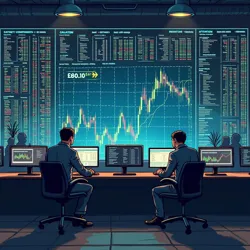Attention Derivatives
 A modern attention derivatives trading interface showing real-time fluctuations in visual engagement futures
A modern attention derivatives trading interface showing real-time fluctuations in visual engagement futuresAttention derivatives represent a complex class of financial instruments that enable trading and risk management in the modern attention economy. These sophisticated contracts derive their value from underlying metrics of human attention, engagement, and visual space utilization. Since their introduction during the First Attention Wars, attention derivatives have become fundamental tools for hedging exposure to volatile attention markets and speculating on future shifts in human engagement patterns.
Historical Development
The concept of attention derivatives emerged from the increasing financialization of human attention following the Great Digital Migration of the 2030s. As corporations began aggressively competing for limited visual real estate, the need for financial instruments to manage attention-related risks became apparent. The first attention futures contracts were introduced by the Chicago Board of Attention Trade (CBAT) in 2032, allowing companies to hedge against fluctuations in the value of their Ambient Surface Rights.
The market experienced explosive growth following Zamagon's landmark acquisition of Southern Hemisphere atmospheric display rights. This massive transaction, which required the deployment of Stratospheric Projection Technology, created unprecedented demand for financial instruments that could help manage the risks associated with large-scale attention space investments. The development of standardized attention measurement protocols by the Surface Categorization Protocol further accelerated market growth by providing reliable metrics for derivative valuation.
Types of Attention Derivatives
Attention Futures
Attention futures contracts represent the most basic form of attention derivatives, allowing parties to agree on a future price for specific types of attention exposure. These contracts typically reference standardized metrics such as Aggregate Visual Engagement (AVE) or Neural Response Units (NRUs), as defined by the Bureau of Cognitive Metrics. The introduction of Visual Territory Futures has been particularly significant in helping companies manage their exposure to fluctuating attention space values.
Engagement Swaps
Engagement swap contracts enable parties to exchange different types of attention exposure, helping to optimize their attention portfolios. For example, a company might swap their rights to morning rush hour visual exposure for evening entertainment district engagement, based on their target demographic preferences. These instruments have become increasingly sophisticated with the development of Emotional Resonance Optimization technologies.
Attention Options
Attention options provide holders with the right, but not the obligation, to acquire specific types of attention exposure at predetermined rates. These instruments have proven particularly valuable in markets affected by Neurological Impact regulations, as they allow companies to maintain flexible attention acquisition strategies while managing regulatory compliance risks.
 The CBAT trading floor during a period of high volatility in the attention futures market
The CBAT trading floor during a period of high volatility in the attention futures marketMarket Structure and Trading
The global attention derivatives market operates through a network of specialized exchanges, with the CBAT and the London Attention Exchange (LAX) serving as primary trading hubs. Trading volume has grown from $50 billion in 2033 to over $4.7 trillion by 2042, driven by increasing sophistication in attention measurement technologies and the expansion of Mixed-Reality Advertising Spaces.
The introduction of Cognitive Liquidity Providers has significantly improved market efficiency by automatically matching buyers and sellers of attention exposure across different timeframes and modalities. These algorithmic market makers utilize advanced neural network models to maintain orderly markets even during periods of extreme attention volatility.
Regulatory Framework
The regulation of attention derivatives falls primarily under the jurisdiction of the Global Attention Rights Commission, which works in conjunction with national financial regulators to oversee market activity. The Commission's Derivative Oversight Protocol establishes standards for contract design, margin requirements, and risk management practices.
Regulatory challenges have emerged particularly around the treatment of derivatives based on Synaptic Marketing Channels and other direct neural advertising technologies. The question of whether neural engagement futures constitute financial instruments or medical devices has led to complex jurisdictional disputes between financial and healthcare regulators.
Risk Management Applications
Corporations actively use attention derivatives to manage various types of attention-related risks. Companies with large investments in Atmospheric Commerce Institute projects often use weather-linked attention derivatives to hedge against atmospheric conditions that might affect their ability to deliver advertisements. Similarly, firms developing Biophotonic Integration technologies use specialized derivatives to manage the risks associated with varying neural engagement rates.
The development of Attention Portfolio Theory has provided a theoretical framework for optimizing exposure across different attention channels and time periods. This has led to the emergence of sophisticated attention-based investment strategies and the creation of dedicated attention hedge funds.
Impact on Attention Markets
The widespread adoption of attention derivatives has profoundly influenced the broader attention economy. The ability to hedge attention exposure has encouraged greater investment in experimental advertising technologies and helped finance the development of new attention capture methodologies. However, critics argue that the growing derivatives market has contributed to the approaching Attention Saturation Crisis by encouraging excessive exploitation of human attention capacity.
Technological Infrastructure
Modern attention derivatives trading relies on sophisticated technological infrastructure to measure and track attention metrics in real-time. The development of Neural Engagement Monitoring systems has enabled more precise valuation of attention-based instruments, while advances in distributed ledger technology have improved market transparency and settlement efficiency.
Future Developments
Industry analysts predict continued innovation in the attention derivatives market, particularly in instruments linked to emerging attention capture technologies. The development of derivatives based on Subconscious Market Engagement metrics represents a significant new frontier, though regulatory challenges remain. There is also growing interest in derivatives that reference collective attention patterns across multiple sensory modalities, reflecting the industry's expansion beyond purely visual attention spaces.
See Also
- Surface Categorization Protocol
- Visual Territory Futures
- Attention Saturation Crisis
- Cognitive Liquidity Providers
- Neural Engagement Monitoring
References
- "The Evolution of Attention Finance" - Journal of Cognitive Economics, 2041
- "Derivatives and the Attention Economy" - Institute of Financial Attention Studies, 2042
- "Risk Management in Visual Markets" - Attention Risk Quarterly, 2040
- "The CBAT Handbook of Attention Derivatives" - Chicago Board of Attention Trade, 2043